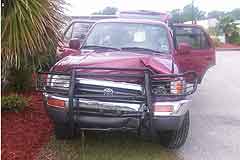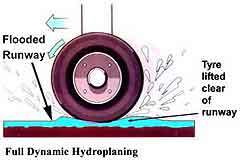Road trips usually mean hours of boredom with, fortunately, a few moments of panic when a deer jumps out of nowhere or suddenly you hit a bit of very slippery road. And while modern vehicles seldom experience brake failures or a tire blowout, they can still happen. Will you be prepared?

Suddenly a deer or large dog darts onto the road in front of your vehicle. Hitting a large horse, cow or deer can do as much damage as hitting another vehicle. Try to avoid hitting the animal by braking or swerving. However, do not risk losing con-trol especially if traveling at high speeds or you are driving on a slippery surface. It is better to hit a rabbit, dog or cat than losing control and crashing into something or rolling over.
If you cannot avoid hitting a large animal like a deer, take your foot off the throttle pedal and steer away from the direction the animal is running. Be prepared for the animal "freezing" and stopping right in front of you vehicle. Try to steer and brake smoothly and try not to panic and lock you brakes. If you miss the animal, be alert for another one since animals often travel in pairs or herds. Also be on the lookout for children who might be chasing a dog or cat.
You hear an explosion and your vehicle veers suddenly to one side. Steering will difficult so keep a firm grip on the steering wheel with both hands while taking your foot off the throttle. As the vehicle slows done, and after you have regained control, apply brakes slowly so you do not lock them up. If at all possi-ble try to come to a stop off to one side of the road so you can safely change the tire.
If your brakes fail, downshift with either a manual or automat-ic transmission. Then gently start applying your emergency brake. Hold the steering wheel firmly since the emergency brake often applies braking action unequally and therefore the vehicle could pull to one side. Try to pump the brakes, as they may have built up enough pressure for one more stop. If you are travel-ing slow enough, or there is nothing in your path besides open road, shut off the engine and coast to a stop.
If you cannot avoid hitting something, chose your "target." Try to hit an impact-absorbing object such as shrubbery, a chain-link fence or energy-absorbing barrels or barriers placed on the roadway espe-cially for this purpose. If you must hit a solid object like a guardrail, building or another vehicle try to do it by sideswip-ing the object rather than having a head-on collision.

Naturally slow down on slippery roads and leave more space between you and the vehicle in front of you. It takes twice the distance to stop safely on wet pavement and five times the distance on ice, sleet or packed snow. If you have to drive through standing water on the road, slow down, but do not brake suddenly. Turn on your windshield wipers and be prepared for loss of visibility from vehicles traveling through the water from the opposite direction. Tap your brakes several times to dry them out after exiting the water. Then do a test stop. If the vehicle pulls to one side, pump the brakes to further dry them out. Do not resume speed until you are sure full braking power has been restored.
About six times more people are killed on wet roads than on snowy and icy roads combined, and just when it starts to rain, the roads are the most slippery. Hydroplaning occurs when your front tires actually "surf" on a film of water. This can make steering ineffective. Hydroplaning depends on the condition of your tires and can occur at speeds as low as 35 mph especially if tires have little tread left. New tires with lots of tread "pump" out water thus resisting hydroplan-ing. However even new tires can hydroplane when the vehicle is moving fast enough, at the time it hits water. Should you start hydroplaning, take your foot off the throt-tle, pump the brakes gently, and firmly hold the steering wheel. Prevent skidding or losing control by keeping the wheels straight, don’t turn or swerve, or jam on the brakes.
If you suddenly suffer reduced visibility because of fog, snowstorm, dust storm or heavy rain, slow down but do not brake suddenly. Watch the vehicles behind you in your rearview mirror. Watch ahead for other vehicles that are slowing down. Turn on you lights and windshield wipers, except in a dust storm. However, never turn on your high beams. Reflections from dust, fog or snow will actually reduce visibility. Even if the lights do not improve your own visibility (as in daylight), they will make it possible for other motorists to see you better. If you need to slow down, tap your brake pedal several times so that the flash of your brake lights will warn motorists behind you. Indeed, if you see someone following too close, tap your brakes, or if safe slow down further so the other driver will pass you.




